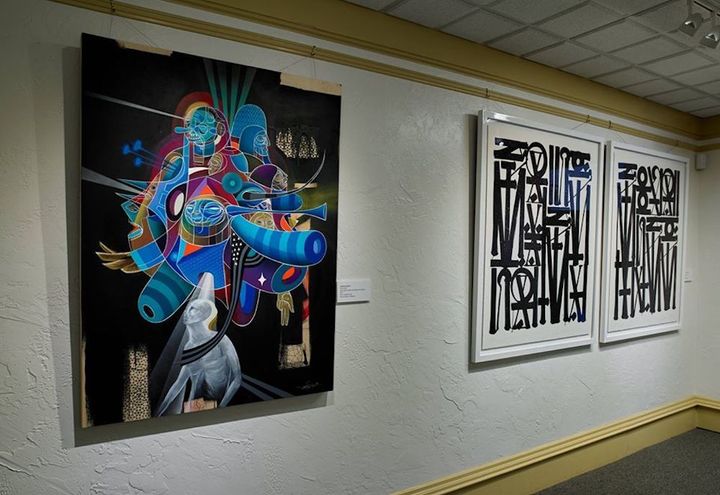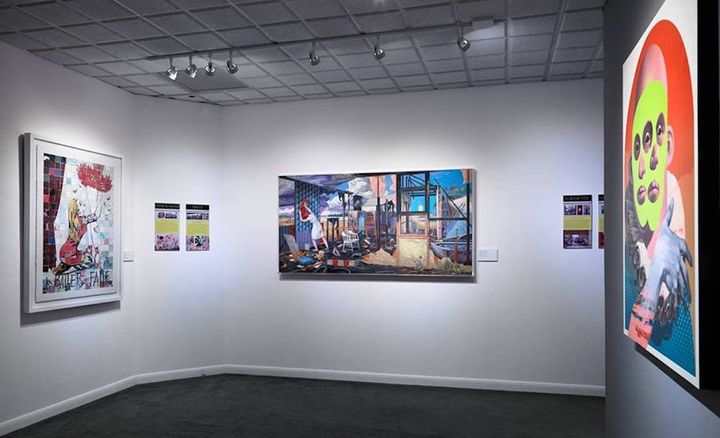
National Institute of Urban Art's inaugural exhibit, Uncontainable, featuring (left to right) works from Shepard Fairey's "OBEY GIANT" series and Brian Douglas
By all accounts, urban art patron Craig O’Neil is a force of nature. A fierce advocate for urban artists, and renowned producer of the now-famous ART History Mural Project at Miami Marine Stadium, O’Neil recently took time aside to speak with us about his hard work helming the National Institute for Urban Art (NIUA) based in Gainesville, Florida, which is currently exhibiting UNCONTAINABLE - a group exhibition of urban artists at the forefront of contemporary art history, making waves internationally with a wide range of bold and inventive styles. The institute proves itself to be a sophisticated endeavor, not only for exhibiting urban art, but for supporting and acting as a key resource for urban artists and art research for today’s urban art aficionados. Our wide-ranging discussion on NIUA’s initiatives contains some surprising details on the institute’s directions, inspiration and other key partners internationally, so let’s dive in!
Thanks, Craig, for taking time to speak today. To begin, can you explain the founding of the National Institute for Urban Art? How did the institute select its name? What factors resulted in the institute coming together, and what need is it filling for the contemporary art world?
I imagine every collector starts to seriously think about what they do with their collection when they die, and as you start to explore the options, there are few exciting ones. It becomes sad to think about the pieces of work that you love and believe are important languishing in a basement somewhere for 99% of their lives. With this in mind, part of the motivation for NIUA was to have a place where the work we have brought together could be shared with a wider audience.
Secondly over the years we have had deep conversation with artists that have become close friends, such as Logan Hicks, and Juan Travieso, about what their lives and careers are like and the challenges they face. We at NIUA see a clear need to support this movement with services in such fields as legal, accounting, career development, that are no-cost or low-cost and focused on artists. More than just exhibiting, this service mission is what drove the founding of NIUA. All historic art movements had patrons and that is needed here, now.
Finally, speaking with gallerists, such as Andrew Hosner and Gregg Shienbaum about art movements, and what art movements need to be impactful over time, it became clear to me that institutional participation and academic study are critical. So far academies and formal institutions have had challenges with engaging with this (the urban art) movement. So we thought it key to provide a place where these two parties could connect and study the many facets of urban art, and speak to people who understood their needs. The NIUA was ultimately inspired by the ICA in Boston, a facility that focuses on art holistically: their work, programming and wider engagement is a constant inspiration to us.

National Institute of Urban Art's inaugural exhibit, Uncontainable, featuring (left to right) works by Swoon, Michael Reeder, and Juan Travieso
How does your own personal history intersect with Urban Art, and what brought you to appreciate this art form?
I left home at 14, and for a time I lived a squat called Rosemary Court in Sarasota Florida. My friends and neighbors in this special place were artists and free thinkers and part of that was what is now “street art”. As I grew up, I faced a crossroads: a choice to enter the business world or to stay on the bohemian path. I chose the former, and I always say that I took the easier road. I invested years of my life into business and eventually made enough to buy some art, and I started buying from my old friends. As time passed, I really started exploring the urban art movement, particularly in the Wynwood area - before it really took off commercially. That period from 2008 to 2011 was really critical (in this movement) with lots of chaos alongside truly great art.

National Institute of Urban Art's inaugural exhibit, Uncontainable, featuring (left to right) works by Doze Green and RETNA
Many art foundations exist to present exhibitions to the public, yet you are setting out to additionally make a positive impact on the urban art community through advocacy. What is the thought process behind this and why is this an important initiative for the NIUA?
I currently live in the contract/ accountants universe, and having lived as an artist for a time I had this sense that I couldn’t really be a great creator while facing down things like indemnity clauses. It’s rare to find someone that can. So as I heard what my artist friends were facing, I realized that I easily could understand how to deal with these challenges: insurance, retirement saving, intellectual property rights - these are things I feel confident about. I found artists, however, to be challenged by it and so I saw that there was real need to provide that help to them by people that they can trust.
This to me is the most important part of what we do, helping people succeed and allowing them to stay focused on the critical things they do which is telling the story of our lives and exploring the human condition.
What was the first work of urban art you collected? Have you developed a discernible style as a collector?
“The Snow Melts the Soonest When” – By Joe Iurato.
We specifically collect studio work by urban contemporary artists and we focus on work that shows a real difference between the street work (and this studio work). For us, street (art) is its own animal, either done illegally and having that fingerprint and uniqueness to it, or done legally, often at massive scale, but made for 40 foot distance viewing. Studio work on the other hand allows an artists to explore their process in-depth, and it should read differently. We specifically seek out work that isn’t just graffiti on canvas but rather something that has echos of the street but could only happen in the studio.
Is the NIUA initiative a part of a global movement to shine a light on urban art? What steps have you taken with the wider community to advance together on a local, regional or international scale?
As you and your readers may now, Urban Nation in Berlin recently opened (there have been talks of a New York institution for some time, and I am certain others in key areas are working on their own projects.) To date we haven’t reached out to pull together a world wide collective of some kind, but from my perspective, I want to ensure our approach is pure. I am not looking to collaborate as a primary step, as I want us to sing our own song. Moving forward though I think the idea of how we learn from each other is incredibly exciting.

National Institute of Urban Art's inaugural exhibit, Uncontainable, featuring FAILE and Brian Douglas
What does the NIUA have planned over the coming year that will speak to urban artists and the wider community alike?
We are deploying our artists services, first with free white papers for artists that cover things like taxes, and common legal issues, and then building out our full time staff in that department to be available for artists to call on.
We are planning our opening exhibition at our larger home, just around the corner from our temporary offices. Our plan is to open March of 2018. Our 5,000+ square foot exhibition and office space that will be our home till we build something specifically for ourselves. We have also been assisting with funding of projects like Swoon’s retrospective at the CAC in Cincinnati.
